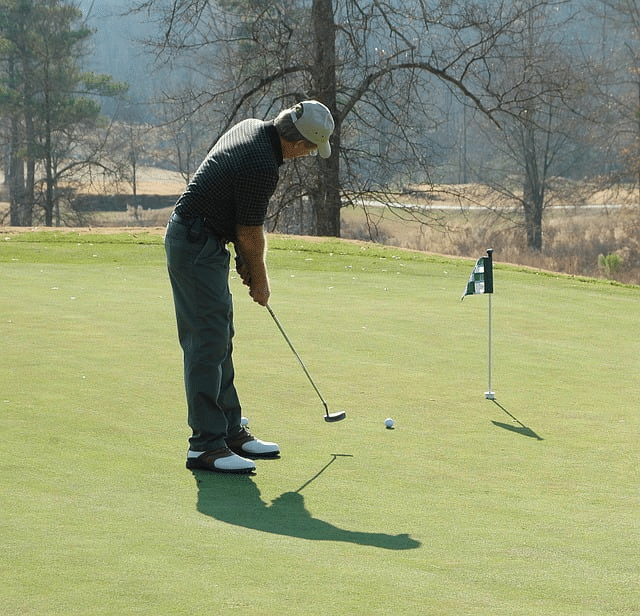Do you struggle to lower your handicap every year despite making golf goals for yourself? I have been there, and it is frustrating. But we are in this together as casual golfers. That is why I prepared this guide to cover setting golf goals.
You will want to learn the difference between a process and an outcome goal. I have provided the guidelines I follow for setting goals and measuring their success. Plus, I share some examples of big and small goals to get you thinking.
How To Set Achievable Golf Goals

When you set a golf goal, you can follow the tried-and-true formula for SMART goals:
- Specific
- Measurable
- Achievable
- Realistic
- Tangible
For example, choosing a goal like going to play twice a week for 6 months is a specific, measurable, and achievable goal for some people. While a goal like, I want to be the best golfer I can be this year isn’t.
This framework will help you avoid unrealistic and intangible goals and consider what you can achieve with your current skill level, time availability, and financial resources.
But there are also a couple of types of goals you can try: Process and Outcome Goals.
Process Goals Are Great for Beginners
A process goal is focused on doing an action. This is great for beginners because you’re not sure what you’re capable of yet.
For example, you could take one swing lesson a week or work on putts inside 10 feet for one hour per week.
Committing and achieving these process goals can help you reach specific outcome goals as well, like breaking 80 or lowering your average score to 81 for the year.
I recently found a list of process goals I set when I was 13 on my quest to become a 9 handicap. I was playing off an 18 but dropped to an 8 after a solid year of dedication.
Here is a rundown of my process goals:
- 1 round of 18 holes a week
- Play one 9-hole practice round a week
- Attend one coaching session a week
- 1 round of chip and putt golf per week
- 2 hours at the range working on my mid and long game per week
- 1 hour on my short, medium, and long putts per week
- 2 hours practicing chips, flops, and bunker shots per week
My process goals were realistic and easy to measure. I only needed to get to the golf course or the driving range daily. I made this list weekly and crossed off each item once I had done it. When the list was complete, I made a new one for the next week and repeated the process.
If I failed to complete one task, I would add it to the list for the following week. For example, if I did not do 1 hour putting, I ensured I did 2 hours the next week to make up for it the next day.
This is just my list but it’s meant to help you come up with a process goal for yourself. You don’t need this many, just one good process goal is enough to get you started.
Read More: What Is A Good Golf Handicap?
Outcome Goals Are Great For Motivation
Outcome goals are focused on hitting a milestone. Your process goals should be geared towards helping you achieve your outcome goal.
For example, my outcome goal when I was an 18 handicapper was to lower my handicap to a 9.
I then created a list of process goals to strengthen my golf game and reach my outcome goal.
I have set numerous outcome goals throughout my 30 years on the golf course and would never have achieved what I have without them.
Here are a list of key outcomes I have worked toward as a golfer:
- Make the team for the World Schools Golf Challenge in New Zealand.
- Go unbeaten in the school league matchplay for the season.
- Lower my handicap to 9.
- Win the A division monthly medal club event.
- Break 80.
- Lower my average score for the year to 80.
- Average 28 putts per round.
- Hit more than 70% of greens in regulation in a season.
- Average over 70% in fairways in regulation.
- Make no more than one 3-putt per round.
- Average above 30 points for 18-hole Stableford tournaments.
You don’t need to try any of these goals, but I’m sharing them to get you started. What outcome goal would you love to hit?
Why Do People Fall Short on Goals?
In my experience, the lack of consistency, perseverance, undefined goals, ill execution, and unrealistic goals are why people fall short.
For example, I was a 25 handicapper and had my sights set on breaking 80 in 6 months. However, I could barely hit a green, most of my drives ended in the right rough, and I was only playing with 10 clubs in the bag. When I did not hit that goal, I was frustrated and ready to give up. But then I had a realization: I needed to set smaller, achievable milestones.
Smaller, achievable milestones helped me track my progress and kept me motivated. I decided to start small and focus on reducing my handicap to 20. I played a smarter game, took irons off the tee on short par 4s, laid up at times on par 5s, and aimed for the middle of the green instead of attacking the flag.
My new approach helped me shave 5 strokes off my game, and three months later, I was playing off a 20. It was not my final destination, but knowing that I had improved over the months boosted my motivation, which pushed me to achieve more.
Best Ideas for Golf Goals for 2024

I thought I would share some outcome goals and the process goals you could use to achieve them. You can easily tweak these to fit your current situation. I also use the golf goal-setting worksheet from Michael S. Shivetts in his thesis on The Effects of Individual Goal Setting.
1. Reduce 3 Putts Per Round
You can reduce your 3 putts per round by practicing your lag putting. Casual golfers tend to misjudge the speed on long putts, leaving a testing second that is often missed. Here is how I reduced my 3 putt record.
- Putt 10 balls each from 10, 15, 20, 30 and 40 feet
- Create a 2-foot radius around the cup.
- Assign scores to each ball (sunk putt = birdie, within the radius = par, outside the radius = bogey)
- If your score is worse than par after putting all 10 balls, you go again from that distance until you achieve a par or better.
- Average 60% of Fairways in Regulation
A 60% FIR record seems unattainable for most amateurs, but it is not if you box smart off the tee. I currently have a 71.4% success rate in hitting the short grass because I predominantly use a long iron or driving iron off the tee. Here is how I improved my record:
- Reduce your driver usage.
- Hit long irons or hybrids off the tee on short par 4 holes.
- Tee your ball up on the side of the box that gives you the clearest route to the fairway.
Read More: How To Hit A Golf Ball Straight
2. Average above 50% in greens in regulation
Hitting the green in regulation gives you the best chance of walking away with a birdie or a par. Most golfers try to attack the flag, but this can cause us to miss the green if we are inaccurate. The solution is simple:
- Aim for the middle of the green
- If you pull or push the ball, you still have a chance of staying on the green
3. Break 90
You can make 17 bogeys and still break 90 on a par 72. It is an attainable golf course goal for high handicappers. This is how I planned and managed to consistently break 90.
- Identify an easy hole on the course where you can make par.
- Play that easy hole defensively to make a par
- Lay up if there is a chance your ball will go in the water
- Aim for the middle of the green
- Focus on getting the ball within the 2-foot radius on long putts for an easy tap-in
Read More: What Percentage Of Golfers Break 100?
4. Lower Your Handicap To 9
The USGA suggests that the average male golfer has a 14.1 handicap. If you fit into this bracket, I recommend targeting a 9 handicap by the end of 2024. I would follow a similar program to what I did when I lowered my handicap from an 18 to a 9.
- Play a round of 18 holes every week
- Attend one coaching session a week
- 1 round of chip and putt golf per week
- 2 hours at the range working on my mid and long game per week
- 1 hour on my short, medium, and long putts per week
- 2 hours practicing chips, flops, and bunker shots per week
Golf Goals To Avoid In 2024
I urge you to avoid general golf goals that are broad and do not help you reach your outcome goals. These are the common golf goals I hear casual players setting but which I advise against.
- Drive The Ball Further: Do not set a goal to drive the ball further because it is not specific, and it is hard to measure your success. What is far for you? Is it a 300-yard drive, or is it 250 yards? Instead, set a specific goal, like averaging 290 yards off the tee this season.
- Shoot Lower Scores: Shooting a low score is not specific enough. What is a low score for you? How often do you want to achieve it? Are you happy to only break 90 once and tick it off the list? Or do you want to average 89 for the year?
- Play More Golf: I hear high handicappers say they want to play more golf this year. What does that mean? Maybe you did not play last year, so if you get one round in, you will have played more golf in 2024. Alternatively, you may play once a month and aim to increase it to once a week. Set a specific number of rounds you want to play so that you can track how close you are to achieving it and when you obtain it.
FAQ
How Do You Set Realistic Golf Goals?
To set realistic golf goals: 1) Assess current skills and average scores, 2) Identify specific areas for improvement like driving accuracy or putting, and 3) Set measurable targets, such as reducing handicap by two points or achieving 75% fairway accuracy. Examples include aiming to play twice weekly, taking monthly lessons, or practicing putting for 30 minutes thrice a week.
What Is a Goal in Golf Called?
The goal in golf is called a “hole,” where players aim to hit the ball into a series of designated holes on the course in as few strokes as possible.
Read More:
Matt has played golf since he was 4 years old and has written over 150 articles at GolfSpan since 2021. Matt specializes in product reviews using his postgraduate degree in Sports Marketing from Johan Cruyff Institute. Matt has a handicap index of 10.8 and currently plays weekly at Pilar Golf Course near his home in Buenos Aires, Argentina. He also loves his Callaway Odyssey Exo Rossie putter and likes a pepper steak pie with curry gravy at the turn. You can connect with him on LinkedIn.







